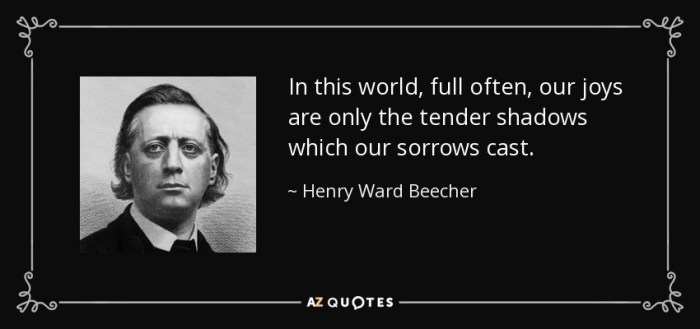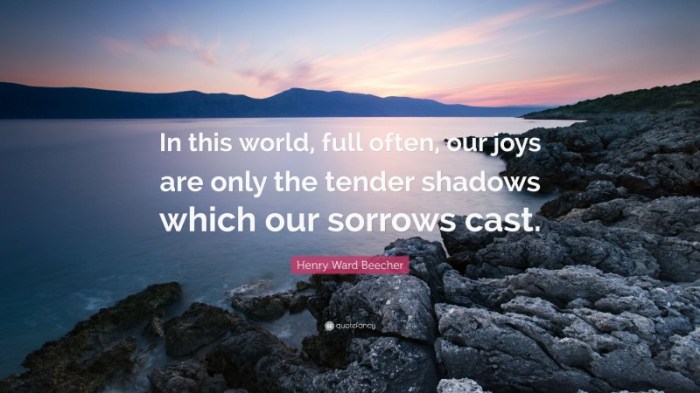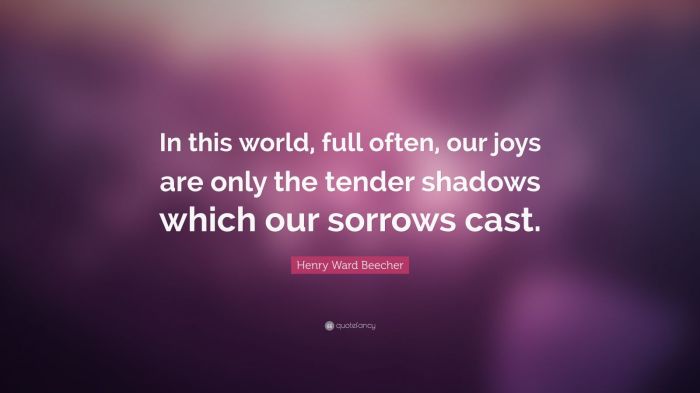Joys are often the shadows cast by sorrows. This paradoxical statement holds profound implications for our understanding of human emotion, the nature of existence, and the creative process. This essay delves into the multifaceted nature of this paradox, examining its psychological, philosophical, and cultural dimensions.
The duality of joy and sorrow is a fundamental aspect of the human experience. We often find ourselves experiencing both emotions simultaneously, or transitioning from one to the other. This paradox challenges our conventional notions of happiness and suffering, and invites us to explore the complex interplay between these seemingly opposing forces.
Defining the Paradox:: Joys Are Often The Shadows Cast By Sorrows

The paradox of “joys are often the shadows cast by sorrows” encapsulates the intricate relationship between two seemingly opposing emotions. Joy, typically associated with happiness and contentment, can paradoxically emerge from the depths of sorrow. This duality arises from the interconnected nature of human experiences, where moments of joy can serve as a poignant reminder of past struggles and the resilience that emerged from them.
Manifestations of the Paradox:
This paradox manifests in various life experiences. For instance, the birth of a child brings immense joy, but it can also evoke memories of the challenges faced during pregnancy or labor. Triumphs in personal or professional endeavors can be accompanied by a sense of relief and gratitude, tempered by the recognition of the obstacles overcome to achieve those milestones.
Psychological and Emotional Implications:
Experiencing joy and sorrow simultaneously can have a profound emotional impact. The contrast between these emotions can create a bittersweet sensation, intensifying the depth of both. This emotional interplay can lead to a more nuanced understanding of the human condition, fostering resilience and appreciation for the complexities of life.
Philosophical and Existential Considerations:
The paradox challenges traditional philosophical perspectives that view joy and sorrow as mutually exclusive. Existentialist thinkers, such as Albert Camus, posit that the recognition of both joy and suffering is essential for a meaningful life. This paradox highlights the inherent duality of existence, where moments of happiness and sadness are inextricably intertwined.
Literary and Artistic Expression:
Literature and art have long explored the paradox of joy and sorrow. In Shakespeare’s “Hamlet,” the protagonist’s melancholy is punctuated by moments of wit and humor, reflecting the complex interplay of emotions within the human psyche. Similarly, in Vincent van Gogh’s “The Starry Night,” the vibrant colors and swirling brushstrokes convey a sense of both awe and longing.
Cultural and Social Perspectives:
Cultural and societal norms influence how joy and sorrow are perceived and expressed. In some cultures, the expression of joy is encouraged, while in others, it is considered inappropriate in the face of adversity. These cultural variations shape the ways in which individuals navigate the paradox and cope with the complexities of human emotions.
Personal and Collective Experiences:, Joys are often the shadows cast by sorrows
Personal experiences and collective events can illuminate the paradox of joy and sorrow. From the shared joy of community celebrations to the collective grief of tragedies, these experiences demonstrate the interconnectedness of human emotions and the ways in which joy can emerge from adversity.
FAQ Guide
What is the significance of the paradox of joys being the shadows cast by sorrows?
This paradox challenges our conventional understanding of happiness and suffering, and invites us to explore the complex interplay between these seemingly opposing forces.
How does the paradox manifest itself in different aspects of life?
The paradox can be observed in personal experiences, artistic representations, cultural norms, and philosophical contemplations.
What are the psychological and emotional implications of experiencing joy and sorrow simultaneously?
Simultaneously experiencing joy and sorrow can lead to a range of emotions, including bittersweetness, gratitude, and a heightened appreciation for life.

